




Designing Origami Models
Part 2 - Adding toes
This essay describes how to convert a long flap into a shorter flap with toes. Two techniques are discusses;
point splitting and strip grafting. I have tried to describe the processes behind each method. Further reading is
recommended:
- Robert J Lang, Origami Design Secrets : Mathematical Methods for an Ancient Art, AK Peters Ltd publishing, 2003; Chapters 5 and 6.
- Peter Engel, Origami from Angelfish to Zen, Dover publishing, 1994
Introduction
In my first essay on designing origami models, I discussed one method of creating a model, which was to follow the sequence of designing a base, positioning major flaps, and then adding finishing touches, such as toes, eyes, horns, etc. In this essay, I'll discuss common ways of adding finishing touches, such as toes. I will also show that they are not always independent of the first two stages.Consider an origami base. It can be a bird base, a frog base, a complex base such as Lang's praying mantis base, or any number of bases. They all have in common a folding sequence that creates a number of flaps. A flap is formed from part of the origami square. It is often a corner, although it can also be from the side, or the centre of the model. It is these flaps that create the main features of the model.
| Suppose you have a simple origami model, such as a simple crow folded from a bird base. It looks elegant enough, but what if you wanted to give it toes? What if you wanted to give it three or four toes on each foot. What methods exist in origami? In Origami Design secrets, Lang discusses this problem in depth, suggesting several methods, two of which are point splitting and strip grafting. | 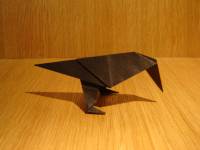 |
Method 1 - point splitting
Consider a flap of paper made from the corner of a square, for example, a flap of a bird base.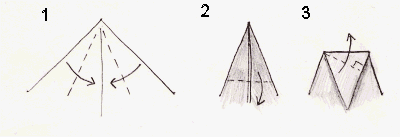
2) Fold the flap down. The exact amount does not matter at the moment
3) Fold the tip of the flap up as shown. The fold lies perpendicular to the edge of the flap
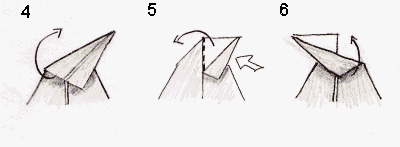
5) Fold over where shown and squash flat
6) Untuck the layer on the other side
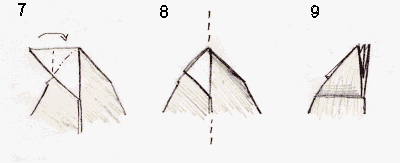
8) You have now split the flap into three points. Close the flap as shown
9) Finished flap
Now unfold the sheet of paper to see what you have folded. Have a look at the creases. This is what is referred to as a Crease pattern. Experienced paperfolders can sometimes fold a model from looking at a copy of a crease pattern alone. The crease pattern should look like this.
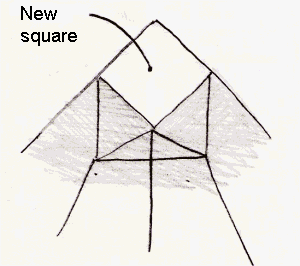
This is not the only method of point splitting. Another method uses almost exactly the same folding sequence. Start again with the corner of a sheet of paper.
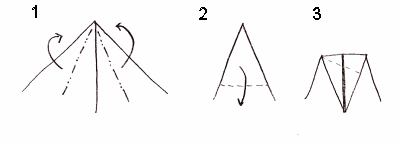
2) Fold down, as before
3) Fold at the same angle, as before
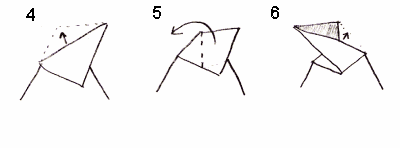
5) Fold over and squash flat
6) Pull some more paper out on the other side
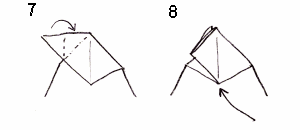
8) Finished point split.
Note that this time, an additional point has been freed, as shown by the arrow. This corresponds to the bottom of the new square in the crease pattern shown above. As a new flap, it is very short, but can occasionally be used to provide detail in origami models.
Putting these point splits into action, consider the simple crow model shown above.
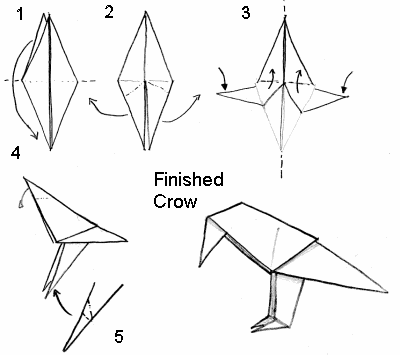
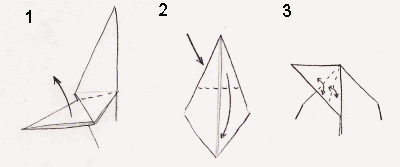
2) Fold the tip as far as is shown. Then look at the first point splitting method described above. Start from step 2 (you already have a long flap, so don't need step 1) and fold as far as the beginning of step 7
3) Make two pre-creases at 45 degrees and 22.5 degrees
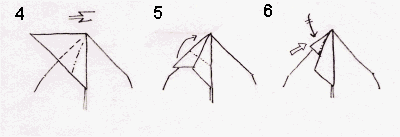
5) Reverse fold up. This creates three toes
6) Make two reverse folds to narrow the toes
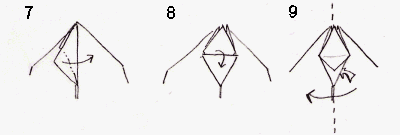
8) This step is optional. There is a flap of paper trapped in the middle which looks like the flap at the centre of a bird base. Untuck it, and flatten the foot.
9) Fold the leg back in half. Note the arrow showing that the squash fold made in step 7 should not be trapped by a layer of paper, otherwise the toes will not open nicely
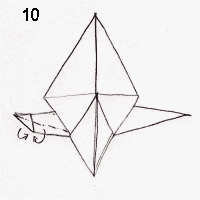 |
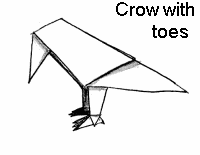 |
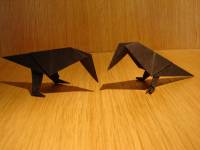
Although this may seem a very useful method to add toes to a flap, there are problems. It can be seen above that the legs of the crow are shorter than the original. For this model, this does not make a huge difference, as the bird base provides very long flaps to begin with. In other models, where the flap is shorter to begin with, creating toes by this method can make the limb far too short.
Method 2 - Strip grafting
Strip grafting is another method to add toes to a model. Here are a few steps to show an example. Start with the
corner of a square.

2) Pleat fold, using the crease as a guide
3) Diagonally fold, bringing the edges to the centre. Turn over
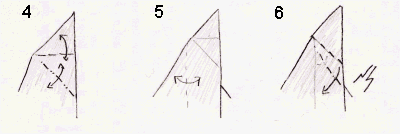
5) Precrease where shown - this will make life a bit easier later on
6) Crimp fold. One fold is on the precrease you made is step 4. The other is an angle bisector between this crease
and the one you made is step 5
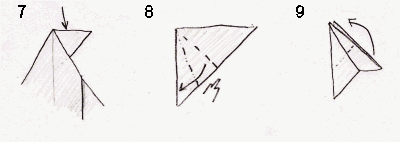
8) Crimp. These folds are at 45 and 22.5 degrees
9) Reverse fold
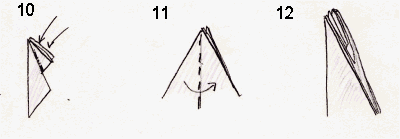
11) Looking at the whole corner now. Fold back over to finish the foot
12) The finished flap, with three new flaps for toes
This method is different from the one above. Rather than converting an existing flap, it requires a change in the
overall design of the model. Going back to the crow design, this method can be used to add toes to a simple
bird-base design.
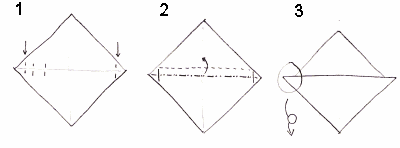
2) Using the 1/16th creases as a guide, pleat-fold upwards
3) The next few steps concentrate on this part of the model
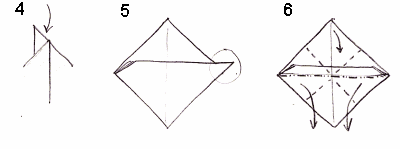
5) Do the same on the other foot
6) You now have a square again. Form your bird base, and fold the bird-base crow as above. Stop at step 3
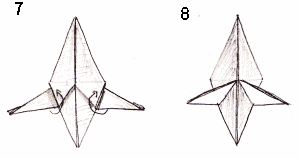
8) Like so. You can now finish off folding the crow
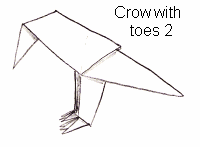
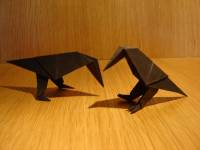
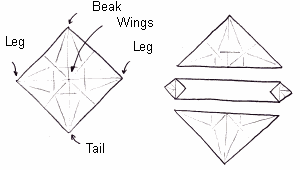
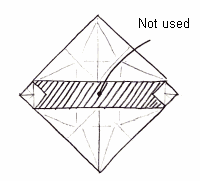
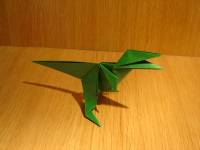
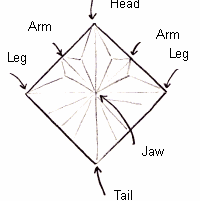
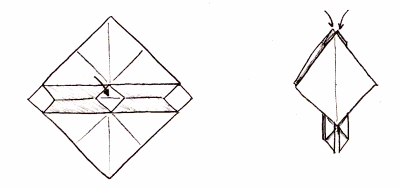
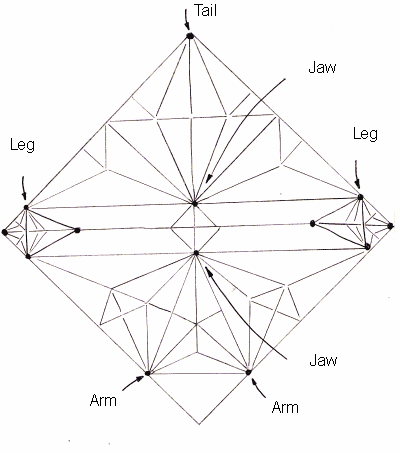
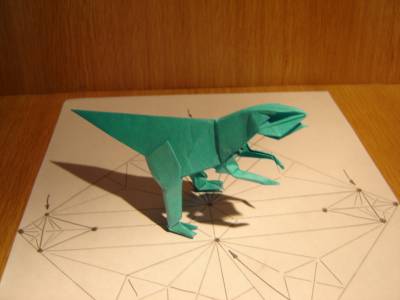
There is a lot more to strip grafting, which I will discuss in a later essay. As well as down the centre of the model,
grafts can be added to an edge, or two edges, or even all around the model. Grafts do not even have to run in straight
line from one corner or edge to another; these grafts can get quite complex. But for now, I'll leave you with adding toes.















